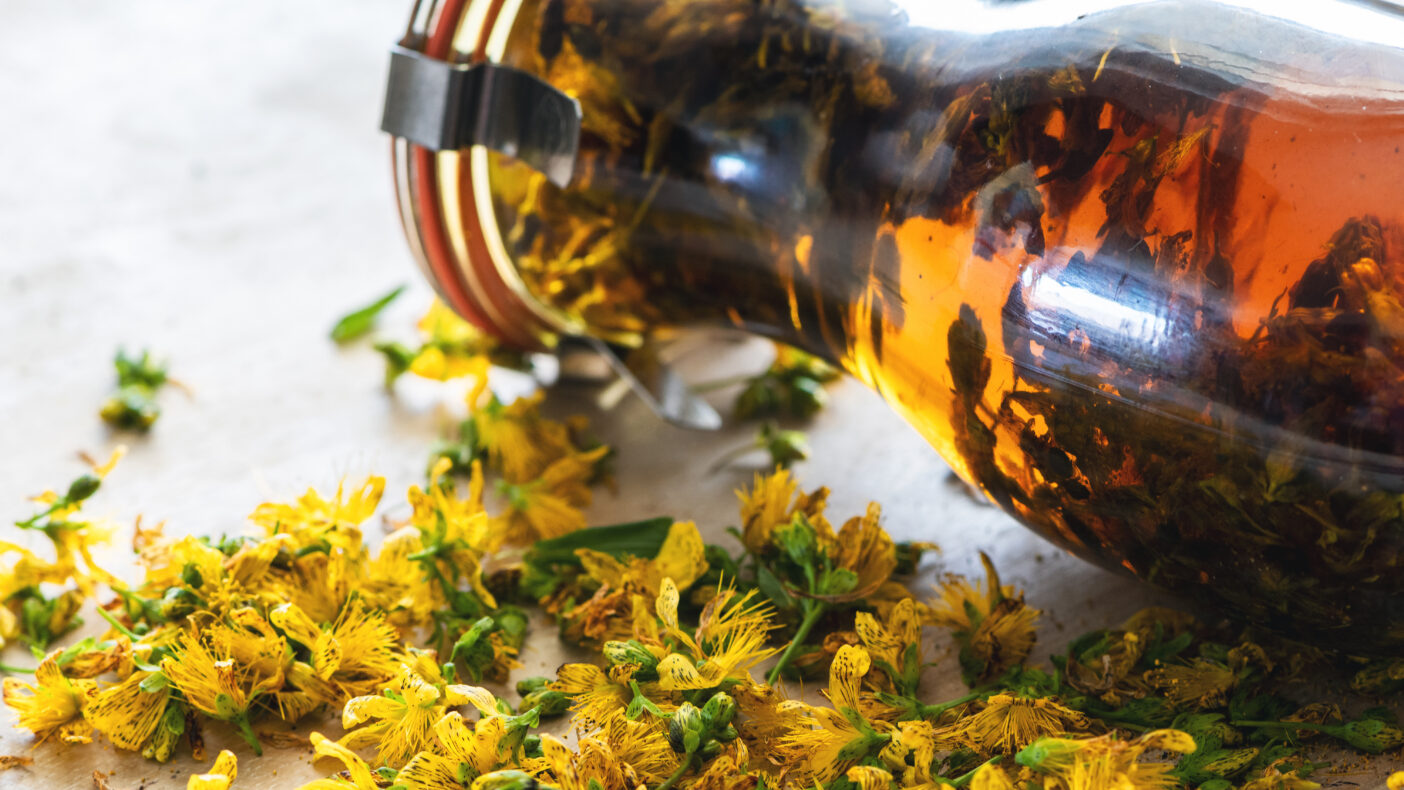St. John’s Wort Oil

St. John’s Wort Oil: A natural wonder with a wide range of effects
St. John’s wort oil, derived from the flowers of St. John’s wort (Hypericum perforatum), is a traditional remedy valued in many cultures for its positive effects on the skin and mental health. In this article, we explore the many uses of St. John’s wort oil, take a look at its active ingredients, particularly hyperforin and hypericin, and consider the physical and chemical properties that make St. John’s wort oil so effective.
What is St. John’s wort oil?
St. John’s wort oil is a red oil made by macerating fresh St. John’s wort flowers in a carrier oil, usually olive oil. The flowers are collected when fully open, typically around Midsummer’s Day at the end of June, hence the name. The oil is well known for its anti-inflammatory, antiviral, and antidepressant properties. It is widely used in alternative medicine to treat a variety of ailments, from skin irritations to mild cases of depression.
Uses of this Oil
St. John’s wort oil can be used in a variety of ways. It is applied topically to treat wounds, burns, bruises and other skin problems. Its anti-inflammatory properties make it particularly effective for relieving pain and inflammation of the skin. St. John’s wort oil is also used to treat nerve-related pain, such as neuralgia or sciatica.
In aromatherapy, this oil is often used to calm and stabilize emotions. It is said to have a calming effect on the nervous system and can be helpful in treating anxiety and depression.
Key active ingredients: hyperforin and hypericin
St. John’s wort oil contains two main active ingredients that are responsible for its therapeutic effects: hyperforin and hypericin. Hyperforin is considered one of the most potent components of the oil and is known for its antidepressant, antibacterial and anti-inflammatory properties. It plays an essential role in the modulation of neurotransmitters in the brain, which gives St. John’s wort oil its effectiveness in treating depression.
Hypericin, another important constituent, is best known for its antiviral and antimicrobial properties. It is also an important factor in the treatment of mild to moderate depression and contributes to the color of the oil by turning red in the oil base.
Physical-chemical properties of St. John’s wort oil
This oil and its active ingredients are characterized by specific physical-chemical properties:
Color: The oil has a characteristic deep red color, which is mainly caused by hypericin.
Solubility: Hypericin is highly soluble in oil, which is crucial for the production of macerated oil.
Melting point: Hyperforin has a melting point of around 30-33°C, which affects its stability under normal storage conditions.
Stability: Both hyperforin and hypericin are sensitive to light, which means that St. John’s wort oil should be stored away from light to prevent the breakdown of these important ingredients.
INCI name: Olea Europaea (Olive) Fruit Oil, Hypericum Perforatum Flower/Leaf/Stem Extract or Olea Europaea (Olive) Fruit Oil, Hypericum Perforatum Extract-depending on the supplier
Safety and side effects
Despite its many benefits, this oil should be used with caution. It can make the skin sensitive to light, which leads to increased sensitivity to sunlight. It is also known to interact with various medications, particularly antidepressants, anticoagulants, and some antibiotics. Therefore, it is important to consult a doctor before using St. John’s wort oil, especially if you are already taking other medications.
This oil is obtained by maceration. Read below to find out how this process works and which products are typically still macerated.
Maceration: process and possible uses
Maceration is a technical process used in particular in the food and luxury food industry to intensify flavor and aroma. It is also known as “maceration” and describes a process in which ingredients of plant or animal products are extracted by the action of a liquid.
The process is commonly used in the production of liqueurs, essences, perfumes and oils. It involves soaking herbs, spices, fruits or other aromatic ingredients in a solvent such as alcohol or water. Over time, the flavors, colors and other valuable ingredients are released into the liquid. The duration and choice of solvent significantly influence the end result and allow for a variety of flavor profiles.
A classic example of the use of maceration is the production of liqueurs such as Amaretto or Limoncello, in which almonds or lemon peel are steeped in alcohol. In the perfume industry, maceration is used to extract fragrant essences from plants and flowers.
The advantage of maceration is that it allows ingredients to be extracted without heating, thus preserving delicate aromas and phytochemicals. It is a traditional method that is now increasingly being used again, especially in the production of high-quality artisanal products.
Summary
St. John’s wort oil is a fascinating and versatile natural remedy that offers a range of health benefits. From treating skin conditions to helping with mental health complaints, St. John’s wort oil can be a valuable addition to any medicine cabinet. With an understanding of how its main ingredients work and a little caution when using it, St. John’s wort oil can help to naturally heal and support both the body and the mind.
Literature:
Hypericum perforatum: Traditional uses, clinical trials, and drug interactions.
Nobakht SZ, Akaberi M, Mohammadpour AH, Tafazoli Moghadam A, Emami SA.Iran J Basic Med Sci. 2022 Sep;25(9):1045-1058
Franco P, Potenza I, Moretto F, Segantin M, Grosso M, Lombardo A, Taricco D, Vallario P, Filippi AR, Rampino M, Ricardi U.Radiat Oncol. 2014 Dec 29;9:297